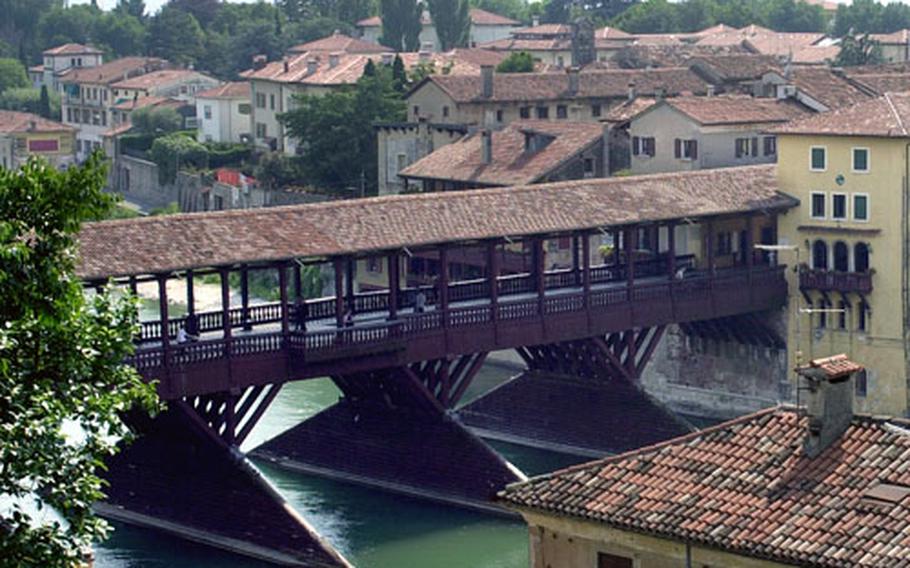
First built in the 13th century, the famed covered bridge at Bassano del Grappa, Italy, has been rebuilt many times. This reconstruction uses Andrea Palladio’s 16th-century design. (Michael Abrams / S&S)
If you never studied architecture, you might not know the name Andrea Palladio.
If you did slog through that field of study, you know he is often described as the most important architect in history.
This summer is the 500th anniversary of Palladio’s birth. To celebrate, the architect’s home province of Vicenza, Italy, will host a series of exhibitions, concerts, guided tours and dinners designed to introduce Palladio to a worldwide audience.
Some 450 years ago, at the end of the Renaissance, the powerful city-state of Venice was the center of a military and commercial empire. After decades of conflict, the empire had entered a rare period of peace, inducing entrepreneurs and the nobility to pursue agriculture as their next business venture.
Moving to the large and mostly undeveloped mainland nearby, workers cleared fields, drained swamps and planted crops. But farm operations could not be managed from Venice; on-site facilities were required. And the noble families needed something beyond the simple huts common to the day. They wanted magnificent homes to reflect their wealth, virtue and importance. They wanted homes suitable for entertaining noble friends. Buildings also needed to be functional — something suited to supervising a large farming operation and storing the grain or wine produced.
This was a new challenge: creating a building that was magnificent, functional and comfortable.
The architect with the solution was Palladio, a former stone mason living in Vicenza. His vision combined a dramatic exterior (to satisfy the owner’s ego), used economical materials (to spare the wallet of that same noble) and created internal balance and harmony (making the interior both beautiful and adaptable to changing needs). This solution was so successful, it has been the foundation of architecture ever since.
Five centuries later, 20 magnificent Palladian villas still stand in the province. Sixteen are so highly regarded that UNESCO declared them a World Heritage Site in 1996.
Not content to work exclusively on country villas, Palladio also created city homes, government palaces, theaters, churches and bridges (the World Heritage List includes 23 of his works in the city of Vicenza).
In addition, in 1570, he published the “Four Books of Architecture.” This prodigious work describes building techniques and materials, discusses the design of staircases and reflects his philosophy on room size and dimensions. It details how to build roads, bridges, basilicas and temples. He emphasizes unifying the “useful” with the “commodious” and stresses that the architect must always remember the important relationship between the building and the place where it stands.
The “Four Books of Architecture” were once standard study in schools around the world and are still used by some. They ensured Palladio’s legacy. Today, when tour guides almost anywhere refer to Renaissance architecture, they are talking about a building that, if not designed by Palladio himself, was constructed in the style he created.
The celebration in Vicenza already has begun. Inside Palazzo Barbaran da Porto in the city center, you’ll find a display of wooden models manufactured on a 1:33 scale that are precise replicas of some of the architect’s finest villas and palaces. Opened at the end of last year, this is a permanent exhibit.
Another exhibit already available is “Virtual Andrea Palladio,” an online tour of the center of Vicenza, where visitors can see many of his landmarks. Find it at www.andreapalladio500.it or at www.comune.vicenza.it, which has a link to “Andrea Palladio 500.”
In June, musical presentations in the famous Teatro Olimpico, one of Palladio’s greatest accomplishments, will help celebrate his life and accomplishments.
And no Italian party would be complete without food. A group of restaurants called Le Risorgive have put together a set menu based on typical recipes of Palladio’s day. Dine on marinated trout, risotto with Jerusalem artichokes, grilled beef and a pine nut and candied fruit tart (price is 25 euros). For information, call Trattoria Molin Vecio at (+39) 0444-585168.
Many country villas Palladio created will be open for guided tours. Every weekend from April through October visitors can see firsthand the beauty and grace of his work. Some villas are private property, so only limited views of the interior will be available. Tours can be arranged by contacting either iat.vicenza2@provincia.vicenza.it, www.palladio2008.info or www.vicenzae.org.
The cornerstone to the celebration is “The Great Exhibition: Palladio.” From mid-September to January 2009, more than 300 works will be on display at Vicenza’s Palazzo Barbaran da Porto. Included will be original drawings, sculptures, paintings and 30 models of some of the architect’s greatest achievements. After its run in Vicenza, this exhibit will stop in London (until May 2009) and then Washington, D.C.
Jim Sajo is a freelance writer who lives in northern Italy.
Know and Go
Just how much did Andrea Palladio influence architecture around the world? Here is a short list of famous landmarks he inspired, according to Vicenza È, the tourist information office for Vicenza province.
• The White House (Washington, D.C.)
• The U.S. Capitol building (Washington, D.C.)
• Jefferson Memorial (Washington, D.C.)
• The National Gallery (Washington, D.C.)
• The Hermitage Theater (St. Petersburg, Russia)
• Bridge of Bassano (Bassano del Grappa, Italy)
• Church of the Redeemer (Venice, Italy)
• Church of the Great Mother (Turin, Italy)
• Cathedral of Helsinki (Helsinki, Finland)
• Mereworth Castle (Kent, England)
• Dublin Parliament (Dublin, Ireland)
• National Museum (Budapest, Hungary)
• Municipal Palace (Amsterdam, Holland)
• Queen’s House (Greenwich, England)
• Woburn Abbey (Bedfordshire, England)
— Jim Sajo